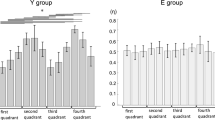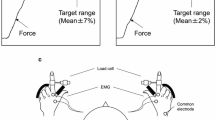Abstract
The purpose of this study was to quantify correlated motor unit activity during isometric, shortening and lengthening contractions of a hand muscle in older adults. Thirteen old subjects (69.6±5.9 years, six women) lifted and lowered a light load with abduction–adduction movements of the index finger over 10° using 6-s shortening and lengthening contractions of the first dorsal interosseus muscle. The task was repeated 10–20 times while activity in 23 pairs of motor units was recorded with intramuscular electrodes. The data were compared with 23 motor-unit pairs in 15 young (25.9±4.6 years, five women) subjects obtained using a similar protocol in a previous study. Correlated motor unit activity was quantified using time-domain (synchronization index; Common Input Strength) and frequency-domain (coherence) analyses for the same motor-unit pairs. For all contractions, there was no difference with age for the strength of motor-unit synchronization, although age-related differences were observed for synchronous peak widths (young, 17.6±7.4 ms; old, 13.7±4.9 ms) and motor-unit coherence at 6–9 Hz (z score for young, 3.0±1.8; old, 2.2±1.5). Despite increased synchrony during lengthening contractions and narrower peak widths for shortening contractions in young subjects, there was no difference in the strength of motor unit synchronization (CIS ~0.8 imp/s), or the width of the synchronous peak (~14 ms) during the three tasks in old subjects. Furthermore, no significant differences in motor-unit coherence were observed between tasks at any frequency for old adults. These data suggest that the strategy used by the central nervous system to control isometric, shortening, and lengthening contractions varies in young adults, but not old adults. The diminished task-related adjustments of common inputs to motor neurons are a likely consequence of the neural adaptations that occur with advancing age.




Similar content being viewed by others
References
Abbruzzese G, Morena M, Spadavecchia L, Schieppati M (1994) Response of arm flexor muscles to magnetic and electrical brain stimulation during shortening and lengthening tasks in man. J Physiol 481:499–507
Adams L, Datta AK, Guz A (1989) Synchronization of motor unit firing during different respiratory and postural tasks in human sternocleidomastoid muscle. J Physiol 413:213–231
Amjad AM, Halliday DM, Rosenberg JR, Conway BA (1997) An extended difference of coherence test for comparing and combining several independent coherence estimates: theory and application to the study of motor units and physiological tremor. J Neurosci Methods 73:69–79
Baker MR, Baker SN (2003) The effect of diazepam on motor cortical oscillations and corticomuscular coherence studied in man. J Physiol 546:931–942
Bremner FD, Baker JR, Stephens JA (1991) Effect of task on the degree of synchronization of intrinsic hand muscle motor units in man. J Neurophysiol 66:2072–2083
Burke D, Hagbarth KE, Lofstedt L (1978) Muscle spindle activity in man during shortening and lengthening contractions. J Physiol 277:131–142
Christou EA, Shinohara M, Enoka RM (2003) Fluctuations in acceleration during voluntary contractions lead to greater impairment of movement accuracy in old adults. J Appl Physiol 95:373–384
Corden DM, Lippold OC (1996) Age-related impaired reflex sensitivity in a human hand muscle. J Neurophysiol 76:2701–2706
Datta AK, Stephens JA (1990) Synchronization of motor unit activity during voluntary contraction in man. J Physiol 422:397–419
Datta AK, Farmer SF, Stephens JA (1991) Central nervous pathways underlying synchronization of human motor unit firing studied during voluntary contractions. J Physiol 432:401–425
Davey NJ, Ellaway PH, Baker JR, Friedland CL (1993) Rhythmicity associated with a high degree of short-term synchrony of motor unit discharge in man. Exp Physiol 78:649–661
Doherty TJ, Vandervoort AA, Brown WF (1993) Effects of ageing on the motor unit: a brief review. Can J Appl Physiol 18:331–358
Eisen A, Entezari-Taher M, Stewart H (1996) Cortical projections to spinal motoneurons: changes with aging and amyotrophic lateral sclerosis. Neurology 46:1396–1404
Eisen A, Siejka S, Schulzer M, Calne D (1991) Age-dependent decline in motor evoked potential (MEP) amplitude: with a comment on changes in Parkinson’s disease. Electroencephalogr Clin Neurophysiol 81:209–215
Ellaway PH (1978) Cumulative sum technique and its application to the analysis of peristimulus time histograms. Electroencephalogr Clin Neurophysiol 45:302–304
Enoka RM, Christou EA, Hunter SK, Kornatz KW, Semmler JG, Taylor AM, Tracy BL (2003) Mechanisms that contribute to differences in motor performance between young and old adults. J Electromyogr Kinesiol 13:1–12
Farmer SF, Bremner FD, Halliday DM, Rosenberg JR, Stephens JA (1993a) The frequency content of common synaptic inputs to motoneurones studied during voluntary isometric contraction in man. J Physiol 470:127–155
Farmer SF, Halliday DM, Conway BA, Stephens JA, Rosenberg JR (1997) A review of recent applications of cross-correlation methodologies to human motor unit recording. J Neurosci Methods 74:175–187
Farmer SF, Ingram DA, Stephens JA (1990) Mirror movements studied in a patient with Klippel-Feil syndrome. J Physiol 428:467–484
Farmer SF, Swash M, Ingram DA, Stephens JA (1993b) Changes in motor unit synchronization following central nervous lesions in man. J Physiol 463:83–105
Halliday DM, Conway BA, Farmer SF, Rosenberg JR (1999) Load-independent contributions from motor-unit synchronization to human physiological tremor. J Neurophysiol 82:664–675
Henderson G, Tomlinson BE, Gibson PH (1980) Cell counts in human cerebral cortex in normal adults throughout life using an image analysing computer. J Neurol Sci 46:113–136
Kararizou E, Manta P, Kalfakis N, Vassilopoulos D (2005) Morphometric study of the human muscle spindle. Anal Quant Cytol Histol 27:1–4
Kido A, Tanaka N, Stein RB (2004) Spinal excitation and inhibition decrease as humans age. Can J Physiol Pharmacol 82:238–248
Kilner JM, Alonso-Alonso M, Fisher R, Lemon RN (2002) Modulation of synchrony between single motor units during precision grip tasks in humans. J Physiol 541:937–948
Kilner JM, Baker SN, Salenius S, Jousmaki V, Hari R, Lemon RN (1999) Task-dependent modulation of 15–30 Hz coherence between rectified EMGs from human hand and forearm muscles. J Physiol 516(Pt 2):559–570
Kilner JM, Fisher RJ, Lemon RN (2004) Coupling of oscillatory activity between muscles is strikingly reduced in a deafferented subject compared with normal controls. J Neurophysiol 92:790–796
Kirkwood PA, Sears TA (1978) The synaptic connexions to intercostal motoneurones as revealed by the average common excitation potential. J Physiol 275:103–134
Kornatz KW, Semmler JG, Meyer FG, Poston BS, Pascoe MA, Enoka RM. (2003) Correlated motor unit discharge is similar for slow shortening, but not lengthening contractions in young and old adults. Soc Neurosci (Abst) 29:914.7
Laidlaw DH, Bilodeau M, Enoka RM (2000) Steadiness is reduced and motor unit discharge is more variable in old adults. Muscle Nerve 23:600–612
Liu JX, Eriksson PO, Thornell LE, Pedrosa-Domellof F (2005) Fiber content and myosin heavy chain composition of muscle spindles in aged human biceps brachii. J Histochem Cytochem 53:445–454
Ljubisavljevic M, Kalezic I, Radovanovic S, Milanovic S, Blesic S, Anastasijevic R (1998) Changes in fusimotor activity during repetitive lengthening muscle contractions in decerebrate cats. Neuroscience 86:1337–1341
Mantel GW, Lemon RN (1987) Cross-correlation reveals facilitation of single motor units in thenar muscles by single corticospinal neurones in the conscious monkey. Neurosci Lett 77:113–118
Moritz CT, Barry BK, Pascoe MA, Enoka RM (2005a) Discharge rate variability influences the variation in force fluctuations across the working range of a hand muscle. J Neurophysiol 93:2449–2459
Moritz CT, Christou EA, Meyer FG, Enoka RM (2005b) Coherence at 16–32 Hz can be caused by short-term synchrony of motor units. J Neurophysiol 94:105–118
Nordstrom MA, Fuglevand AJ, Enoka RM (1992) Estimating the strength of common input to human motoneurons from the cross-correlogram. J Physiol 453:547–574
Pitcher JB, Ogston KM, Miles TS (2003) Age and sex differences in human motor cortex input-output characteristics. J Physiol 546:605–613
Rosenberg JR, Amjad AM, Breeze P, Brillinger DR, Halliday DM (1989) The Fourier approach to the identification of functional coupling between neuronal spike trains. Prog Biophys Mol Biol 53:1–31
Sale MV, Semmler JG (2005) Age-related differences in corticospinal control during functional isometric contractions in left and right hands. J Appl Physiol 99:1483–1493
Schieber MH, Thach WT Jr (1985) Trained slow tracking. II. Bidirectional discharge patterns of cerebellar nuclear, motor cortex, and spindle afferent neurons. J Neurophysiol 54:1228–1270
Schmied A, Pagni S, Sturm H, Vedel JP (2000) Selective enhancement of motoneurone short-term synchrony during an attention-demanding task. Exp Brain Res 133:377–390
Schmied A, Pouget J, Vedel JP (1999) Electromechanical coupling and synchronous firing of single wrist extensor motor units in sporadic amyotrophic lateral sclerosis. Clin Neurophysiol 110:960–974
Sears TA, Stagg D (1976) Short-term synchronization of intercostal motoneurone activity. J Physiol 263:357–381
Semmler JG (2002) Motor unit synchronization and neuromuscular performance. Exerc Sport Sci Rev 30:8–14
Semmler JG, Kornatz KW, Dinenno DV, Zhou S, Enoka RM (2002) Motor unit synchronisation is enhanced during slow lengthening contractions of a hand muscle. J Physiol 545:681–695
Semmler JG, Kornatz KW, Enoka RM (2003a) Motor-unit coherence during isometric contractions is greater in a hand muscle of older adults. J Neurophysiol 90:1346–1349
Semmler JG, Kornatz KW, Meyer FG, Enoka RM (2003b) Diminished task-related plasticity of common inputs to hand muscle motor neurons in older adults. Aust Soc Med Res 42:38
Semmler JG, Sale MV, Meyer FG, Nordstrom MA (2004) Motor-unit coherence and its relation with synchrony are influenced by training. J Neurophysiol 92:3320–3331
Semmler JG, Steege JW, Kornatz KW, Enoka RM (2000) Motor-unit synchronization is not responsible for larger motor-unit forces in old adults. J Neurophysiol 84:358–366
Skinner HB, Barrack RL, Cook SD (1984) Age-related decline in proprioception. Clin Orthop Relat Res 208–211
Sosnoff JJ, Vaillancourt DE, Newell KM (2004) Aging and rhythmical force output: loss of adaptive control of multiple neural oscillators. J Neurophysiol 91:172–181
Swash M, Fox KP (1972) The effect of age on human skeletal muscle. Studies of the morphology and innervation of muscle spindles. J Neurol Sci 16:417–432
Taylor AM, Enoka RM (2004) Quantification of the factors that influence discharge correlation in model motor neurons. J Neurophysiol 91:796–814
Turker KS, Powers RK (2001) Effects of common excitatory and inhibitory inputs on motoneuron synchronization. J Neurophysiol 86:2807–2822
Verschueren SM, Brumagne S, Swinnen SP, Cordo PJ (2002) The effect of aging on dynamic position sense at the ankle. Behav Brain Res 136:593–603
Yao W, Fuglevand RJ, Enoka RM (2000) Motor-unit synchronization increases EMG amplitude and decreases force steadiness of simulated contractions. J Neurophysiol 83:441–452
Acknowledgments
The authors would like to thank Drew Kern, Michael Pascoe, and Brach Poston for assistance during some experiments and with motor-unit discrimination. This work was supported by National Institutes of Health grants AG09000 and NS42734 awarded to RME.
Author information
Authors and Affiliations
Corresponding author
Rights and permissions
About this article
Cite this article
Semmler, J.G., Kornatz, K.W., Meyer, F.G. et al. Diminished task-related adjustments of common inputs to hand muscle motor neurons in older adults. Exp Brain Res 172, 507–518 (2006). https://doi.org/10.1007/s00221-006-0367-0
Received:
Accepted:
Published:
Issue Date:
DOI: https://doi.org/10.1007/s00221-006-0367-0




